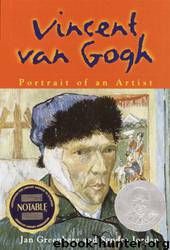Vincent Van Gogh by Jan Greenberg

Author:Jan Greenberg [Greenberg, Jan]
Language: eng
Format: epub
ISBN: 9780307548740
Publisher: Random House Children's Books
Published: 2001-12-05T23:00:00+00:00
I would like to paint in such a way that everybody,
at least if they had eyes, would see it.
—LETTER TO THEO, AUGUST 1888
IN HIS BRIGHT BLUE postman's uniform with gold buttons, Vincent's new friend, Joseph Roulin, sat stiffly posing for his portrait. Vincent thought the postman looked like Socrates, with his large head, ruddy cheeks, and long salt-and-pepper beard. He painted quickly, as Roulin could hardly contain himself. His wife had just delivered a baby girl, and he was “proud as a peacock and aglow with satisfaction.” He promised Vincent he could paint the baby in her cradle, and then he proceeded to sing the “La Marseillaise,” the French national anthem, in a terrible voice, vowing to christen his daughter at home instead of at church. Vincent thought him more inter-esting than anyone he'd met in Arles. When he finished the portrait, the Roulins invited him to stay for supper. Roulin, after a bottle of wine, expounded on his socialist politics and offered the younger artist advice about life. For Vincent, who long ago had lost faith in his own father, Roulin, “so wise and so trustful,” became a father figure: “Roulin has a salient gravity and tenderness for me such as an old soldier might have for a young one.” He painted eight versions of the postman, as well as portraits of Mrs. Roulin and their two sons. Despite his poverty, Roulin refused to be paid, so Vincent ended up buying him food and many drinks at the local café. He also gave the Roulins paintings. Spending time with them helped Vincent feel less lonely, more a part of a family life he missed.
Also at this time Vincent painted a flamboyant portrait of a soldier of the Algerian infantry, whom he gleefully described as “a man with a small face, a bull neck, and the eye of a tiger.” The soldier faces the viewer in full Zouave uniform. His legs, clad in wild red pantaloons, are spread wide, taking up a fourth of the canvas. Vincent liked the style of this portrait—“vulgar, loud”—in opposition to the overly refined portraits that the rich commissioned in Paris. He painted his other friend in the regiment, Paul-Eugène Milliet, but complained that the young, handsome soldier was a bad poser and too much of a womanizer to sit still. Milliet probably wouldn't get the girls, Vincent grumbled to Theo, if he were an artist.
Though he often forgot mealtimes when he painted, Vincent was concerned about eating properly and wrote to Theo that he'd finally found a café that served decent food. Near his yellow house, the Café de la Gare was run by Mr. and Mrs. Ginoux. He painted her as a classically beautiful Arlesienne wearing an elegant black dress.
He also spent some nights living at a cheap inn, the Café Alcazar, before his yellow house was completed. The bar was open all night and attracted the “night prowlers,” who had no money for lodging. Before long Vincent started on a painting of the interior, staying up for three nights and sleeping all day.
Download
This site does not store any files on its server. We only index and link to content provided by other sites. Please contact the content providers to delete copyright contents if any and email us, we'll remove relevant links or contents immediately.
| Cartooning | Drawing |
| Fashion | History |
| Painting | Sculpture |
| Fiction | Techniques |
Audition by Ryu Murakami(4840)
The House on Mango Street by Sandra Cisneros(3394)
Draw-A-Saurus by James Silvani(2653)
Dork Diaries 12 by Rachel Renée Russell(2329)
Born Out of Wedlock by Lyn Gardner(2185)
Frankly, Frannie by AJ Stern(2168)
Miss Peregrine's Home for Peculiar Children by Ransom Riggs(2166)
The Audition by Maddie Ziegler(2155)
Origami Art by Michael G. Lafosse & Richard L. Alexander(2062)
I Know Why the Caged Bird Sings by Maya Angelou(2024)
Yerma by Federico García Lorca(2015)
Sophie's World by Jostein Gaarder(1965)
1936941139 (N) by Bob Rosenthal(1833)
Fashion 101 by Erika Stalder(1804)
I know why the caged bird sings by Maya Angelou(1778)
Hamnet by Maggie O'Farrell(1684)
Romancing the Nerd by Leah Rae Miller(1650)
Being Nikki by Meg Cabot(1595)
Star-Crossed by Barbara Dee(1547)
